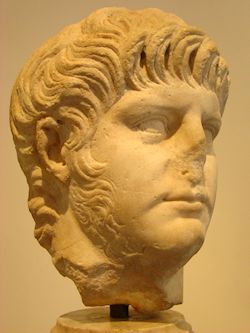
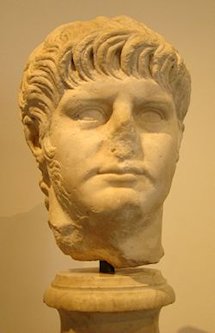
It is not known why the bust was originally interpreted as being a portrait of Constantine the Great (AD306–337), for the coiffure is clearly influenced by the Julio-Claudian styles of the 1st century AD, while Constantine himself was, in reality, the first emperor since Hadrian (in AD117) to be depicted clean-shaven in official portraiture. Presumably this is one of the eighth Earl of Pembroke's more questionable attempts to provide an identification. If so, it is somewhat ironic in that, in equating the bust with 'CONSTANTINVS MAGNVS', the first emperor to actively tolerate Christianity, Pembroke missed the more obvious affiliation with Nero, the pioneer of Christian religious persecution.


Although the perils of 'Zeitgesicht' ('period-face') and 'Bildnisangleichnung' ('image assimilation') in both private and court portraiture have already been noted (Zanker 1982; Massner 1982; Fejfer 2008, 270-85; see also 2.3), it is evident that the Wilton portrait, as seen 'face-on' in the 3D laser scan without the distraction of both restored mouth and nose, is that of the young Emperor Nero. The square, fleshy chin, lack of bone-structure in the cheeks, dimpled mouth and crisply defined eyes deeply set beneath straight brows precisely match the known portraiture of this particular princeps from his later first and second coiffure types, initiated between AD54 and 64 (Kleiner 1992, 138; Varner 2000, 48-9). Good comparisons for the established physiognomy of the Wilton head may be found in the portrait of a lightly bearded Nero created for his fifth anniversary in power (AD59), originally found on the Palatine Hill in Rome (Kleiner 1992, 138: hence often referred to as the 'Terme Museum type') and now in the Museo Nazionale delle Terme (Figure 10) and a bust in the Worcester Art Museum, Massachusetts (Figure 11), thought to commemorate his tenth year (in AD64: Kleiner 1992, 138: hence often referred to as the 'Terme Museum type').
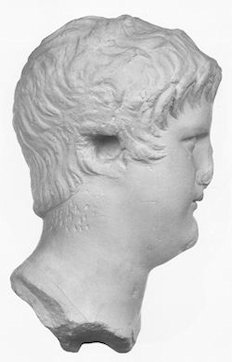
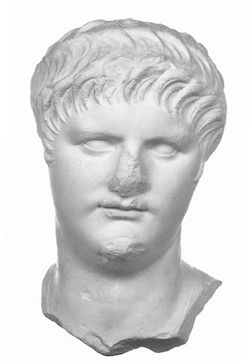
Although the facial characteristics of the Wilton, Terme and Worcester heads evidently match, what distinguishes the Wilton portrait in particular is the treatment of the hair. Post AD59 images of Nero possess increasingly elaborate and ornate coiffures, full, thick waves of hair being arranged in slightly raised parallel strands across the forehead of the Terme portrait, while the Worcester head possesses a prominent quiff or crest, comprising curls that have been pushed up from the forehead (and described by Suetonius (Nero, 51) as being shaped into terraces - coma in gradus formata). This distinctive quiff, apparently unique to Nero, clearly appears in his later coinage where it accompanies a more corpulent image of the fifth emperor, but does not occur in association with the Wilton head.
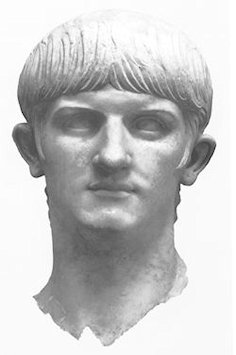
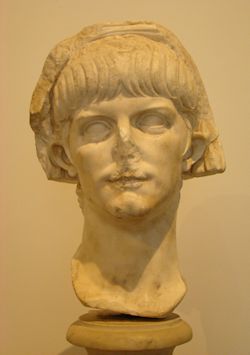
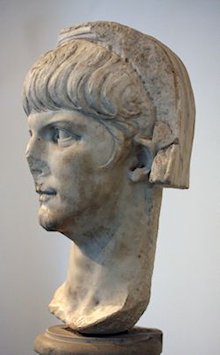
In contrast to the later, more full-faced and bearded images of the post accession, second and third coiffure type Nero, Michaelis no. 202 from Wilton possesses a more developed version of his earlier, first coiffure, individual locks brushed forward in long strands and parted in a light, slightly off-centre V. The latest replicas to possess this more traditional, Julio-Claudian style, which dates to between AD55 and 59 (Cagliari, Museo Nazionale Inv. 35533; Hiesinger 1975, plate 21; Kleiner 1992, 137-8), are referred to as the 'Cagliari type' after a head of Nero on display in the Museo Nazionale Cagliari (Figure 12a), although other good examples can be found in the Museo Nazionale delle Terme in Rome (Figure 12b) and the Palazzo Ducale in Mantua (Hiesinger 1975, 114-15). The Cagliari portrait, although clearly of a more mature Nero than depicted in the 'adoption' and 'heir apparent' types, preserved at Parma, Paris, Petworth, Cologne and Copenhagen, is not as fleshy in the cheeks and chin as the Wilton head, nor does it possess the more sunken eyes.
The changing sequence of Nero's portraiture on coin and in stone has already been referred to, with at least five major types identified as having been produced in order to celebrate an important event in his reign, namely his adoption (in AD50), acknowledgement as heir apparent (in AD51), accession (in AD54) and fifth and tenth anniversaries in power (AD59 and 64 respectively: Hiesinger 1975; Kleiner 1992, 135-9; Varner 2000, 126-30; 2004, 47-9). The version recorded in the heavily mutilated portrait from Wilton has the simple hairstyle evident in the latter phases of Nero's first major coiffure type together with the lightly incised beard and bulky physiognomy common in his second and third. This is a combination not certainly attested before and suggests that the portrait must have been generated after AD54, but before AD59/60, at which point Nero's coiffure became increasingly ornate, straying from the more austere styles of his predecessors.
There can be only one explanation for this apparent discrepancy: that the Wilton head is a 'missing link' in the plastic portraiture of the fifth emperor, marking a key stage in the transformation between Nero the young man and Nero the mature princeps. This is perhaps nowhere clearer than in the hairstyle for, although the Wilton coiffure fits within the more sober Julio-Claudian models, the nature of cascading locks, which possess more life and energy than those depicted in the portraits of Augustus and Claudius, suggests that this particular image was commissioned at the point at which Nero was starting to experiment with his appearance, allowing hair more freedom to roam across both his forehead and chin, facial hair never before being so prominently depicted, prior to the more overly elaborate and stylishly ornate styles that would appear later in his reign.
The presence of a possible transitional replica, of 'Wilton Type', between the serious youth of the first coiffure type and the more flamboyant individual that Nero was to become in his second and third coiffure types, has already been hinted at, Diana Kleiner noting that a second marble portrait of the fifth emperor preserved in the Museo Nazionale Romano at Cagliari conforms, in basic style, to the Cagliari or 'accession type', having a version of Nero's first coiffure, but combined with the more fleshy features of his later portraits (Kleiner 1992, 137-8). The head (Cagliari, Museo Nazionale Inv. 6122), apparently derived from mainland Italy rather than from Sardinia itself (Hiesinger 1975, 115), certainly appears to combine the bulkier face of a more mature Nero with the coiffure of the younger man, hair parted on the forehead in a discrete central V. Unfortunately, precise identification is impossible, the Cagliari bust having been extensively defaced, the nose, lips, chin and ears all being removed and the hair and back of the head extensively disfigured with a chisel (Hiesinger 1975, 115; Varner 2004, 50, 237). The extreme nature of violence directed to the portrait (which also included scratching the word VICTO (to the conquered) across the chest: Hiesinger 1975, 115), makes it difficult to record any useful observations concerning the form and nature of the original, there being some suggestion that the bust may originally have been a copy of Nero's heir apparent type, later recarved and covered in stucco, in order to create a version of either his accession or quinquennial anniversary type (Varner 2004, 237).
The Wilton head, despite being damaged and fragmentary, is overall in a considerably better state of preservation than the Cagliari bust with regard to key elements of the face and hair, and thus provides the first conclusive evidence that a transitional, perhaps even experimental, replica type existed and that the official portraiture of Nero did not switch seamlessly from the more traditional, Julio-Claudian models of his first coiffure type to the later, more ornate and flamboyant styles of his second and third. Such a transitional form, clear evidence for which has so far proved elusive, marks a sixth discrete type in the portraiture of Nero, set between his accession (coin type III, first coiffure) and quinquennial (coin type IV, second coiffure) anniversary models.